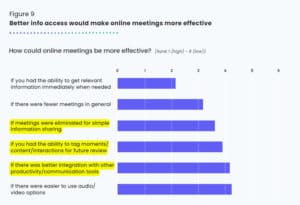New Research Shows That 40% Of Tech Worker Meetings May Be Waste Of Time
There seem to be endless studies about the impact of Hybrid Work. Microsoft’s most recent study, supported by academic studies, shows a significant decline in cross-functional communications when people work from home. And we have all read the studies about Zoom fatigue, the need to get fresh air, and the importance of physical activity during our stint in the hybrid work environment.
Well, some new research just came out (sponsored by Guru and Loom), developed through surveys and interviews with 500 software professionals this month. And it reinforces something that I’ve heard anecdotally all year: people are just wasting too much time in online meetings.
As the research points out clearly, there are two types of interactions at work: asynchronous (you respond whenever you have time), and synchronous (someone calls a meeting or conference call). As the report discusses, whenever someone “calls a meeting” there is a slight sense of dread. Ugh, another video meeting. I guess I have to comb my hair, clean up my office, and get online. You can see the stress on people’s faces.
 And then there’s this terrible need to “check-in” with everyone at every meeting. I call it the “Global Climate Change” minute, where we all talk about the weather in our area, what kind of flood or fires we’re dealing with, and why it seems to be unseasonably hot (or cold). Of course, this doesn’t happen in every meeting, but it happens a lot of the time. And before you know it, ten minutes are burned up on the niceties and many of us are already doing our emails in the background.
And then there’s this terrible need to “check-in” with everyone at every meeting. I call it the “Global Climate Change” minute, where we all talk about the weather in our area, what kind of flood or fires we’re dealing with, and why it seems to be unseasonably hot (or cold). Of course, this doesn’t happen in every meeting, but it happens a lot of the time. And before you know it, ten minutes are burned up on the niceties and many of us are already doing our emails in the background.
I’m not saying this is all bad, we all need to feel connected with our teammates. But as the Guru-Loom research points out, software professionals definitely feel there’s a lot of time wasted. More than half the respondents said that 40% of their meeting time is utterly wasted, which leads me to believe that most software teams would rather just “get the meeting going” and then go back to work. And I often feel that way as well.
 |
The research also points out that “finding just the right information” is what people want most, not a general discussion or sharing of information or a global search to scan for the information you need. Of course Guru and Loom kind of specialize in this stuff, but in our company we use an end-to-end Microsoft Teams environment and it’s very very easy to find “Just what you need.” In larger companies this is a massive challenge.
 The bottom line for me is that “managing meetings” has to change. There’s no reason to schedule a one-hour meeting if 30 minutes will do, and there’s no reason to schedule 30 minutes if ten minutes will do. You can skip the niceties now and then and just discuss the issue, then hang up. It works fine and people take a deep breath and go back to work. (And by the way, the research also shows that most software people really like working from home.)
The bottom line for me is that “managing meetings” has to change. There’s no reason to schedule a one-hour meeting if 30 minutes will do, and there’s no reason to schedule 30 minutes if ten minutes will do. You can skip the niceties now and then and just discuss the issue, then hang up. It works fine and people take a deep breath and go back to work. (And by the way, the research also shows that most software people really like working from home.)
Real-life meetings suffer from the same problem, of course. I remember hundreds of meetings at Deloitte where we had to go around the room and let everyone reflect on their ideas, and I often felt like I was watching my life pass before my eyes. In large companies these alignment meetings are important, but as this research shows they can be more for managers than the staff.
Our new mantra is that face-to-face meetings are for things that are Complex, Critical, or Emotional. In those cases, it’s good to take the time to talk, listen, socialize, and discuss. But for many synchronous communications, a quick phone call or brief meeting is fine.
We’re all learning about new work practices and it’s time to be creative. Let’s stand up and walk around, keep the meeting short, and point people to precisely the information they need.
If you’re in the engineering or software industry, I encourage you to read this study – it will definitely open your eyes.
Additional Resources


